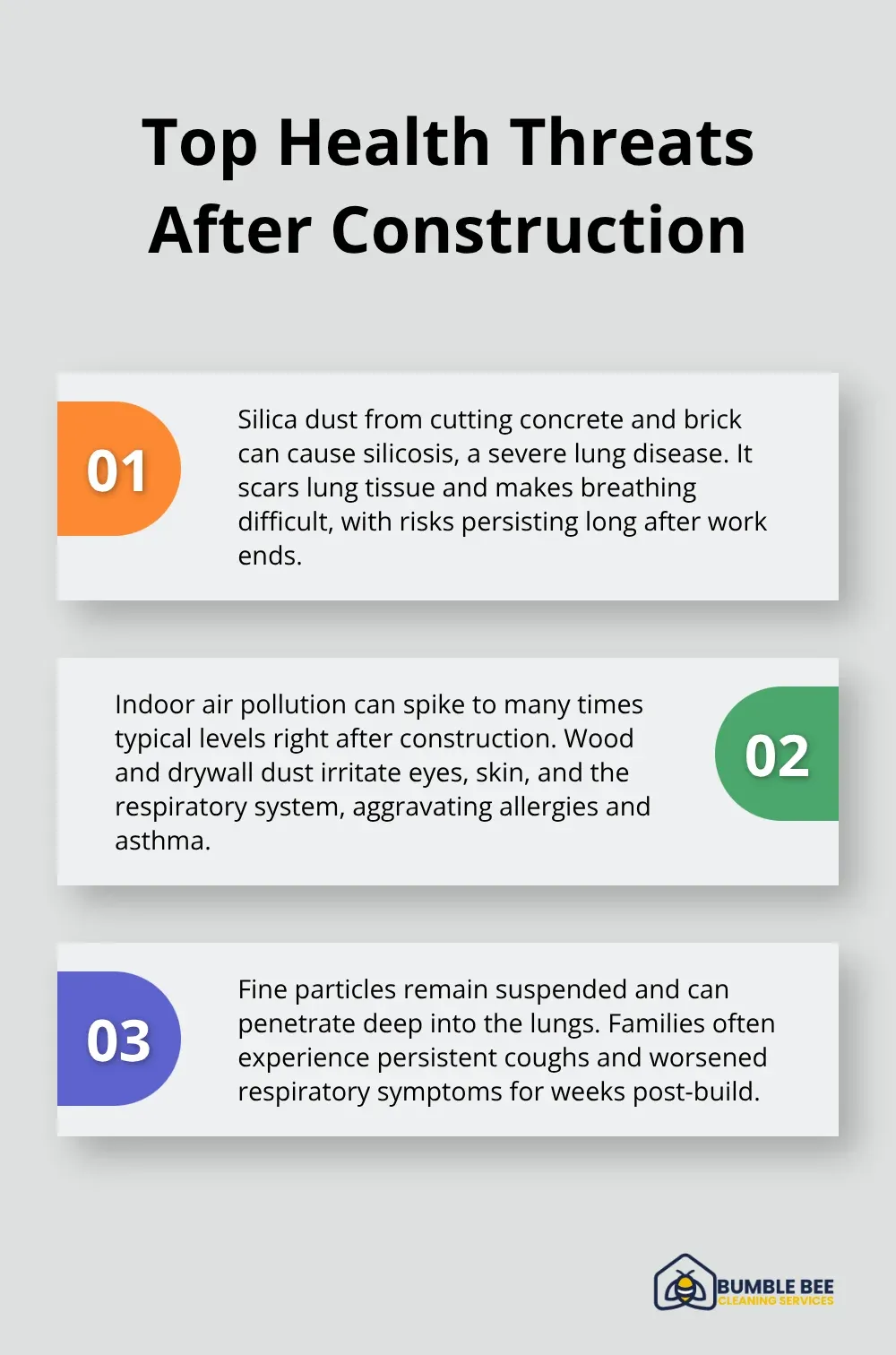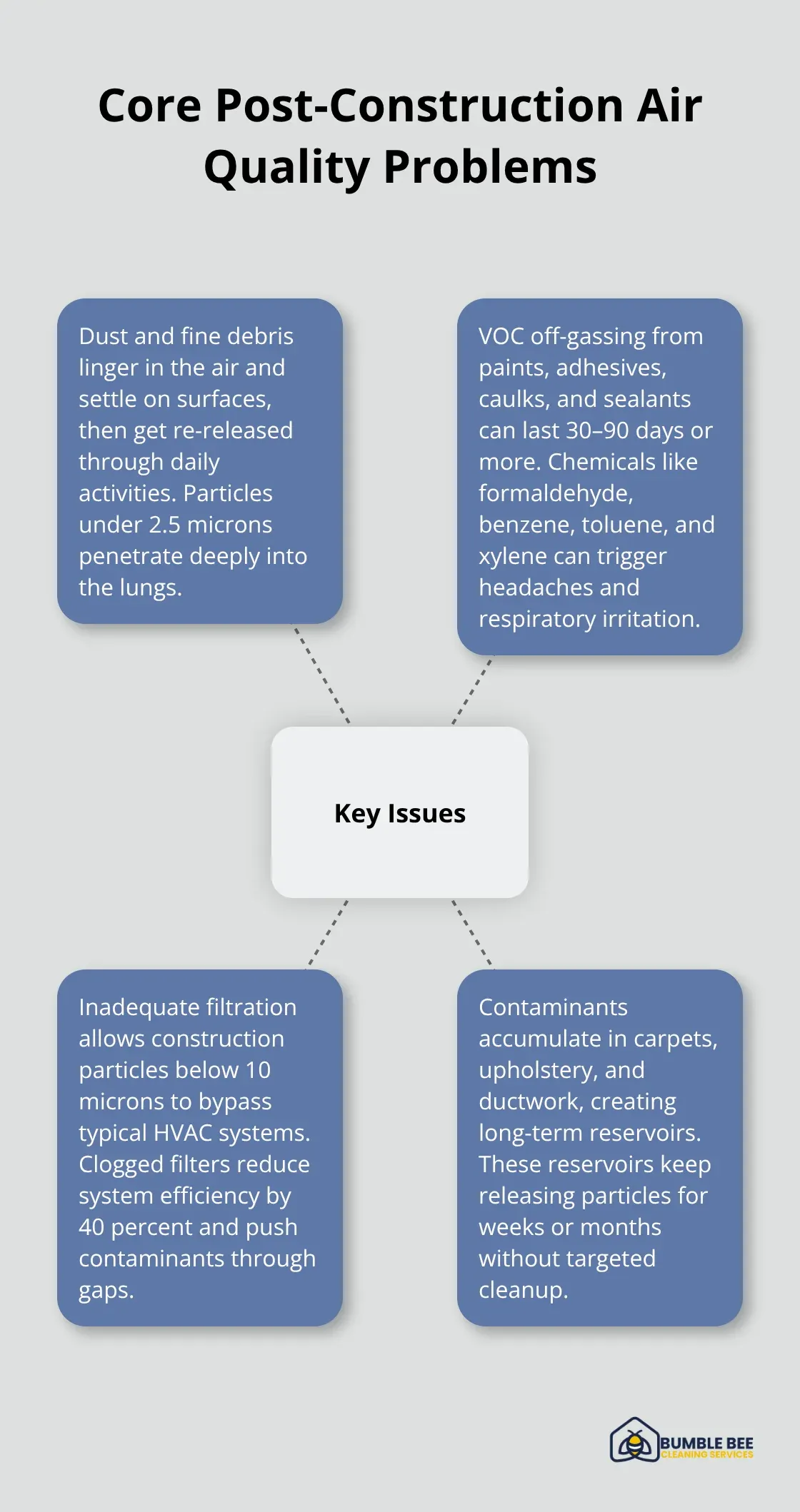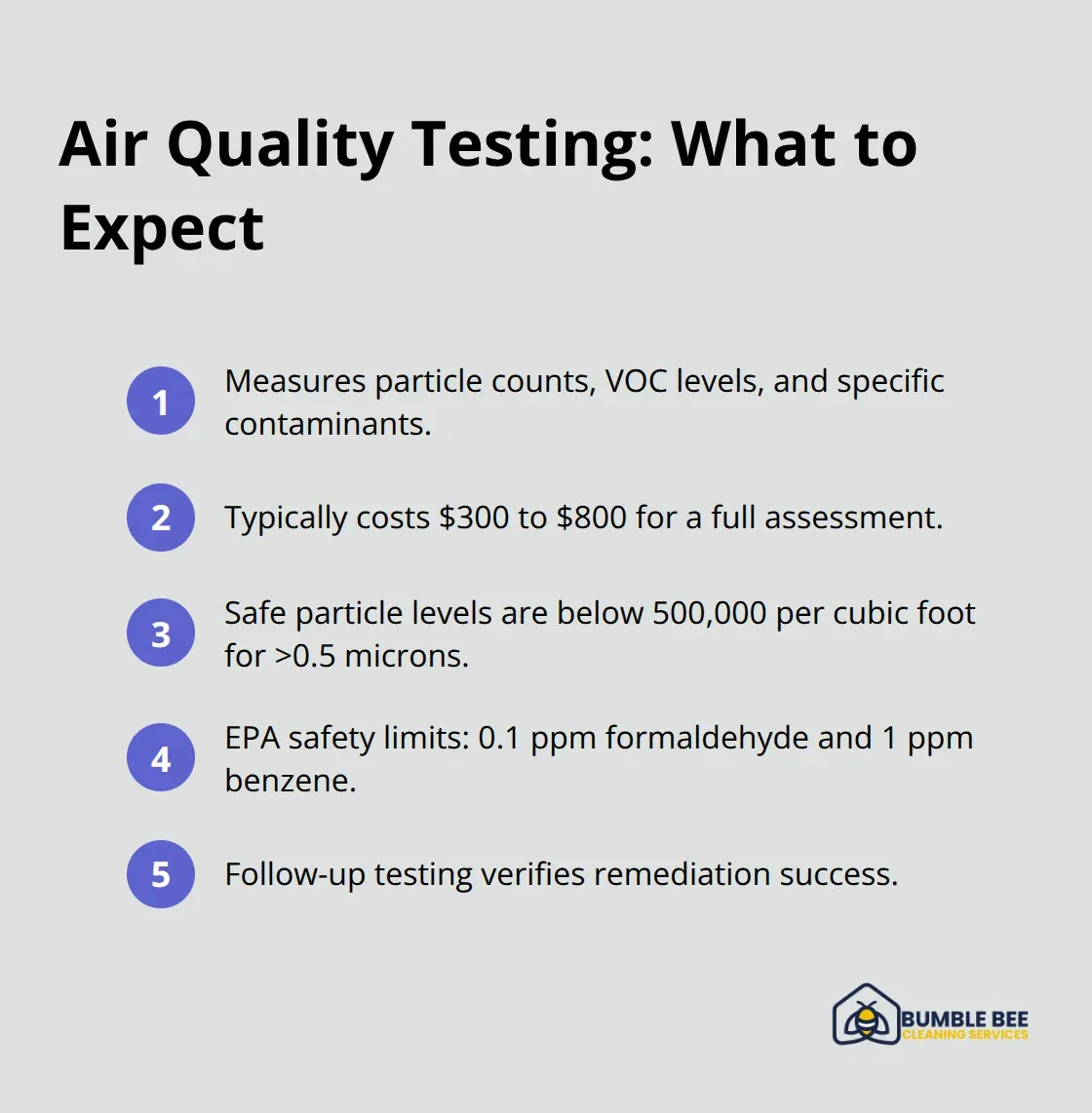Your Seattle construction project is complete, but the work isn’t over yet. Post-build air quality can pose serious health risks that many homeowners overlook.
Construction activities leave behind invisible contaminants that continue affecting your indoor environment for weeks or months. We at Bumble Bee Cleaning Services see firsthand how poor air quality impacts families after renovation projects.
Taking immediate action protects both your health and your investment in your newly constructed or renovated space.
Health Risks from Poor Indoor Air Quality After Construction
Construction dust contains dangerous particles that directly threaten your family’s health. Silica dust from concrete and brick cuts causes silicosis, a severe lung disease that scars tissue and makes breath difficult. The EPA confirms that indoor air pollution becomes two to five times higher than outdoor levels after construction work. Wood dust from materials like Western red cedar triggers conjunctivitis, allergic rhinitis, and asthma attacks. Drywall dust irritates your eyes, skin, and respiratory system (especially problematic in Seattle’s damp climate where particles linger longer).

Construction Dust and Debris Health Effects
Fine particulate matter penetrates deep into your lungs and causes premature death in people with heart or lung disease, nonfatal heart attacks, and irregular heartbeat. Common symptoms include persistent coughs, wheezes, and aggravated asthma that can last weeks after construction ends. Prolonged exposure also leads to decreased lung function and worsened respiratory conditions. Seattle homeowners consistently report worse respiratory conditions and increased allergy symptoms after renovation projects due to construction dust throughout their homes.
Chemical Fumes and VOC Exposure Dangers
Paint fumes and adhesive residues release volatile organic compounds that cause headaches, dizziness, and eye irritation within 24-48 hours. These chemical vapors also cause loss of coordination, nausea, and damage to liver, kidney and central nervous system. Lead paint dust in homes built before 1978 poses extreme risks and requires certified professional removal (homes constructed during this era commonly contain these hazardous materials). Chemical residues also cause skin irritation and chemical burns through direct contact.
Respiratory Problems and Allergic Reactions
Mold spores and allergens multiply rapidly in post-construction environments where moisture combines with organic debris. These contaminants trigger immediate allergic reactions and worsen existing asthma conditions. Construction activities also disturb settled dust from HVAC systems, which then circulates harmful particles throughout your entire home. The combination of chemical vapors and biological contaminants creates a perfect storm for respiratory distress that affects your family’s daily comfort and long-term health.
These air quality problems don’t resolve on their own and require specific solutions to address each type of contamination effectively.
Common Air Quality Issues in Post-Construction Spaces
Construction activities create three distinct air quality problems that persist long after workers leave your property. Dust particles smaller than 2.5 microns remain airborne for hours and penetrate deep into your lungs, while particles between 0.3 and 10 microns settle on surfaces and get redistributed through normal daily activities. The National Institute for Occupational Safety and Health reports that standard home ventilation systems cannot capture particles smaller than 10 microns, which means your HVAC system actually spreads contamination throughout your home rather than removes it.
Dust Particles and Fine Debris Circulation
Drywall dust contains gypsum and silica particles that measure 0.1 to 100 microns, with the most dangerous particles below 5 microns where they bypass your nose and throat defenses. Concrete cuts produce silica dust as small as 0.1 microns that stays suspended in air for 12 to 24 hours after work stops. Wood particles from sanded and cut materials range from 0.5 to 50 microns, with cedar and pine dust that causes the most severe allergic reactions in Seattle residents. These microscopic contaminants accumulate in carpet fibers, upholstery, and HVAC ducts where they continue to release into your air for months.
Paint Fumes and Adhesive Off-Gassing
Paint releases formaldehyde and benzene for up to 60 days after application, with concentrations that peak during the first week when levels can reach 10 times normal indoor limits. Adhesives used in floors and cabinetry emit toluene and xylene that cause neurological symptoms at concentrations above 1 part per million. High indoor concentrations of VOCs can cause health impacts such as headaches, nausea, respiratory infections, allergy, and asthma. Caulks and sealants continue to off-gas for 30 to 90 days, which creates a toxic cocktail that affects your family’s health daily.
Inadequate Ventilation and Air Circulation
Standard residential HVAC systems move air at 400 to 1,200 cubic feet per minute but lack filtration capable of capture for construction particles below 10 microns. Construction debris clogs air filters within days, which reduces system efficiency by 40 percent and forces contaminated air through bypass gaps. Seattle’s humid climate makes the problem worse as moisture combines with dust to create paste-like residues that stick to ductwork and continue to release particles. Your ventilation system becomes a distribution network for contaminants rather than a solution, which requires specialized cleaning and filtration upgrades to restore healthy air quality.

Professional solutions address each of these contamination sources through targeted approaches that standard home maintenance cannot achieve.
How Can You Restore Safe Air After Construction
HEPA filtration systems capture 99.97% of particles as small as 0.3 microns, which makes them the only effective solution for post-construction air purification. Professional-grade air scrubbers move 500 to 2,000 cubic feet per minute through multiple filtration stages and remove particles that standard home systems cannot touch. These units run continuously for 72 to 120 hours after construction completion and reduce airborne contaminants by 95% within the first 24 hours. Portable HEPA units cost $200 to $800 for purchase, but rental options at $50 to $150 per day make them accessible for most projects. Industrial air purifiers with activated carbon filters also remove chemical vapors and VOCs that cause headaches and respiratory irritation.
Professional Deep Cleaning Eliminates Hidden Contaminants
Professional post-construction cleaning follows a top-to-bottom approach that standard housekeeping cannot match. HEPA-filtered vacuums remove settled dust from surfaces, while wet methods capture particles that dry methods redistribute into your air. Construction debris requires specialized disposal methods and Seattle maintains comprehensive waste prevention and recycling programs for construction materials. Ductwork cleaning removes accumulated dust and debris that continues to circulate through your HVAC system for months after work completion. Professional cleaning reduces dust levels by 80% to 90% compared to standard methods, which protects your family from ongoing exposure to harmful particles.
Air Quality Testing Confirms Safety Levels
Professional air quality testing measures particle counts, VOC levels, and specific contaminants like formaldehyde and benzene that affect your health. Testing costs $300 to $800 but provides concrete data about contamination levels rather than guesswork about air safety. Results show particle counts per cubic foot, with safe levels below 500,000 particles for spaces larger than 0.5 microns. VOC testing identifies chemical concentrations above EPA safety limits (0.1 parts per million for formaldehyde and 1 part per million for benzene).

Follow-up testing after remediation confirms that cleaning and filtration efforts successfully restored safe air quality for your family.
Final Thoughts
Post-build air quality improvements deliver measurable health benefits that protect your family for years after construction ends. Clean indoor air reduces respiratory symptoms by 60% to 80% within the first month and prevents long-term lung damage from silica and chemical exposure. Your property value increases when you address contamination issues immediately rather than allow them to cause structural damage or health problems that affect future sales.
Professional remediation costs $500 to $2,000 but prevents medical expenses that average $3,000 to $8,000 annually for families with construction-related respiratory conditions. Seattle’s humid climate makes immediate action even more important as moisture combines with contaminants to create persistent health hazards (especially during our long rainy seasons). Quick response protects both your investment and your family’s wellbeing.
We at Bumble Bee Cleaning Services provide comprehensive post-construction cleaning with HEPA filtration and specialized dust removal that standard methods cannot achieve. Our team uses eco-friendly products to restore safe air quality in your newly constructed or renovated space. Action now protects both your investment and your family’s health for decades to come.
